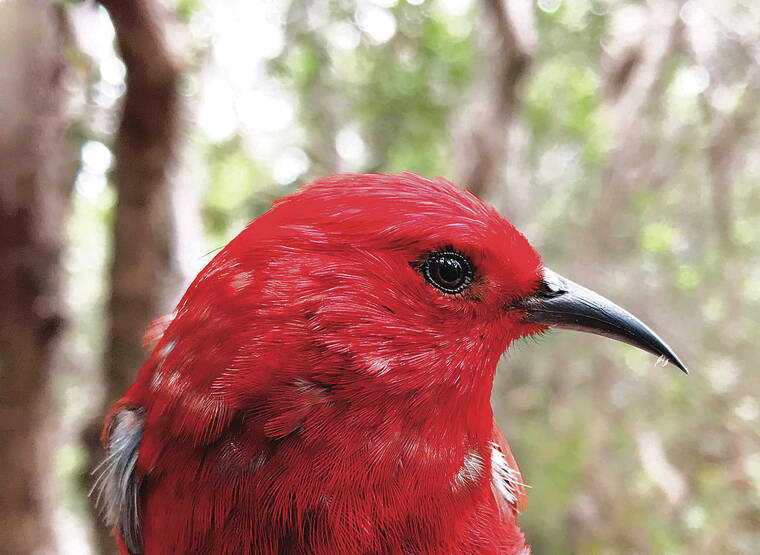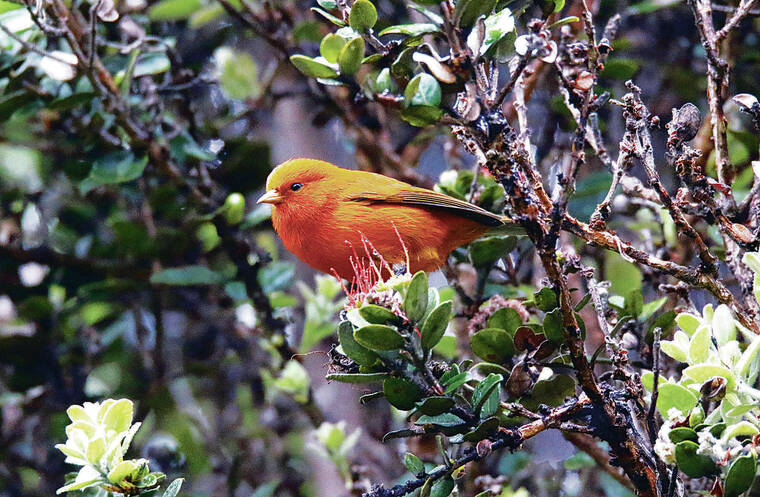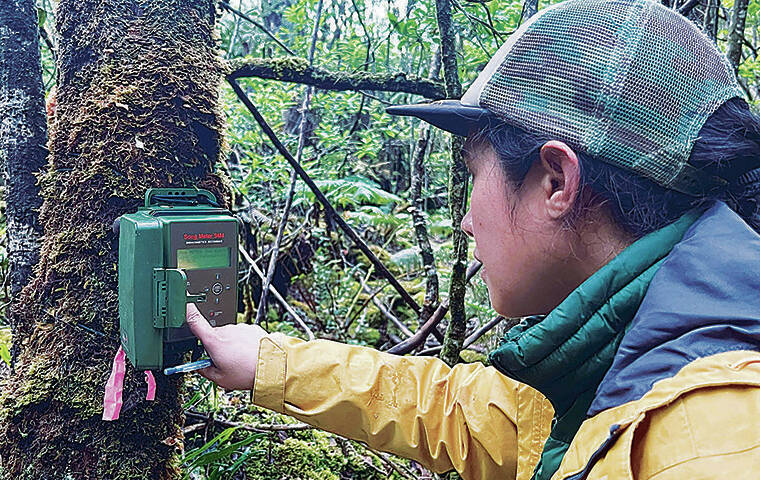Sound data, processed by AI, tracks animal movements while promoting culture



Patrick Hart studies birds so intently on Hawaii island, he’s nearly becoming one.
Over the phone, Hart bursts into a bird song midconversation, mimicking the rhythmic and guttural noise of the uau bird one second and the perky tone of the akepa in the next.
ADVERTISING
“Diddili, diddili, diddili,” Hart sings over the phone.
The head professor at the University of Hawaii at Hilo’s Listening Observatory for Hawaiian Ecosystems, or LOHE Lab, and host of Hawaii Public Radio’s “Manu Minute” has long studied birds but now serves as an unofficial middleman between the ancient and modern ways of preserving Hawaii’s native bird species through song.
The sounds he mimicked were not merely picked up in the forests he studies; they were also acquired through acoustic recorders propagated throughout the state that track the movements of Hawaii’s forest birds.
The recorders “fit in the palm of your hand,” Hart said, and collect the bird sounds for months at a time, which are then inputted into an AI algorithm that the LOHE Lab developed with Google’s Bioacoustics Research Group, trained to detect the bird songs and calls of every species.
Sound becomes data, Hart said, which can consequently be used to estimate the actual abundance of each type of bird in Hawaii’s forests.
“It’s a benign way to study birds that has never been done before,” Hart said.
It also saves time.
Hart said prior to this collaboration, which started in a data set from two months of soundscape, it would take one person two weeks to analyze the data. Now it takes the AI model 10 minutes to complete it.
The speed has an impact on the reaction time of addressing the needs of native birds, Hart said.
“Our birds are just so susceptible to all of these human-caused problems, so most of native birds are declining,” Hart said. “We can do more to manage them like control predators or reduce impact of mosquitoes across the landscape, but we really need to know where the birds are and how much they’re decreasing if at all.”
Today about 25 native land-bird species remain left throughout Hawaii, only around 16 of which are endangered mainly due to human-caused problems, Hart said.
“If you hear about birds in Hawaii, it’s often doom and gloom like we’re losing our birds and they’re declining for all of these reasons and there’s nothing we can do, but there’s actually all of these positive things that are happening, too,” Hart said. “This is just an improvement of the way we can help our birds thrive.”
In Hawaii, birds are both ecologically and culturally important, making their preservation of utmost priority for both Hart and those involved in Ahuimanu, a group of around 10 bird lovers dedicated to perpetuating knowledge of native birds through oli, or Hawaiian chants.
Led by cultural practitioner and kumu Kekuhi Kanahele Keali‘ikanaka‘ole, who was unavailable for an interview, Ahuimanu has met for the past few years to share cultural and scientific knowledge about native bird species, which Keali‘ikanaka‘ole helps create into oli, Hart said.
“It’s just a great group of people, and Kekuhi is a great mentor and collaborator,” Hart said. “We’re using an ancient format of communication in a new way to address our modern conservation problems.”
That connects the public and the group’s participants to birds in a different way, said Ahuimanu member and ethnographer Noah Gomes.
As a Native Hawaiian, Gomes said it’s important to remember that interconnection, especially as someone who works in conservation and ethnography can be weighed down by scientific processes.
“Naturally, the way that you engage with your work and the landscape is from a particular perspective — you have to, you’re trained to,” Gomes said. “When we use things that include chants to ground us in this spiritual and emotional way, and remind us the ways that we’re connected to the landscape around us.”
Ahuimanu, which roughly translates to a gathering of birds, meets once every few weeks and performs occasionally. It recently performed at the opening ceremony of the 2025 Merrie Monarch Festival in Hilo, where members chanted as kii akua, or idol images, and a kuahu (a hula halau’s altar dedicated to the goddess Laka) were marched into Afook-Chinen Civic Auditorium.
“It makes (bird conservation) more approachable for others,” Gomes said. “It’s easy to feel detached, so this is a way to help other people connect as well.”
Hart said audiences always react positively, especially as many of the chants mimic the actual bird songs and calls he hears in the field, while encouraging the audience to repeat some of the sounds.
The main chant, dedicated to Hawaii’s native bird species, is inspired by the Kumulipo, or Hawaiian creation chant, where each verse mimics a bird song, Hart said.
“It connects to the work we do in the lab, but it also makes it fun to perform because for each bird the human version of what it says turns out to be very hilarious,” Hart said.
Beyond birds
The AI technology itself also advances the study of Hawaii’s animal communities across land and sea, Hart said.
In recent months the LOHE Lab has started to rent out the recorders to about 20 groups across the state who study “any animal that makes sounds,” like whales, dolphins, opeapea (bats) and coqui frogs.
Those groups will then send their sound data back to the LOHE Lab, where Hart and his team of researchers and technicians will run it through the AI systems for data analysis.
That includes Nate Dube of the Oahu Invasive Species Committee, a UH research program that targets and responds to high-priority invasive species, specifically those that are just beginning to become a problem, like Oahu’s coqui frogs, little fire ants and devil weed.
On Oahu, OISC has focused on the containment and eventual eradication of the island’s coqui frogs, infamous for their loud, incessant calls late at night.
While Dube and his team do not rent out Hart’s recorders, they place their own sound recording devices in Palolo and Waimanalo — where Oahu coquis thrive — and will send their data back to the LOHE Lab, where Hart’s team will analyze it pro bono.
“Before this, it was all done anecdotally by a person going out and listening, and that can be really helpful to be determining presence and absence in an area, but really difficult to keep any kind of constant (analysis) when you’re having different folks go out and listen and trying to make any population estimates off of that can be really difficult,” Dube said.
While the tech is not advanced enough to determine the population estimates of Oahu’s coqui frog population just yet, it can provide relative-density data, which is already a step in the right direction, Dube said.
It’s been making a difference in how much in financial and physical resources they put into going into the field, especially as many of the frogs go into wild lands, forests, stream beds and running up against the head wall of the Koolau Mountains in Waimanalo.
“Our typical treatment methods aren’t working, so what these sound recorders and data analysis of the audio are fulfilling for us is when we do test out new treatment methods, they can really help inform if these are being successful, and if it’s not successful, then that saves us from dedicating more time, more money towards those kinds of treatments,” Dube said.
Culturally and scientifically, the research has sparked conversation on what the future of researching animals might look like. Hart sees sound as a “passive way to get data about animals.”
“It’s just a box sitting there; it doesn’t require a lot of experts going out there and gathering data,” Hart said. “You can archive all of this information and store them forever. These are all things we can do now that we could never do before.”







